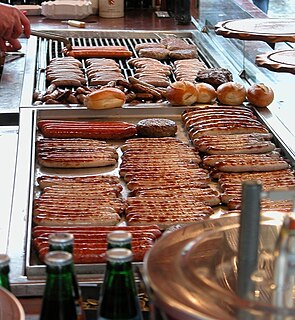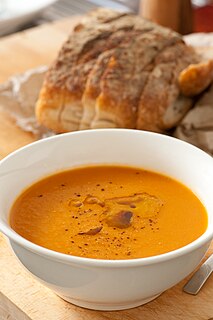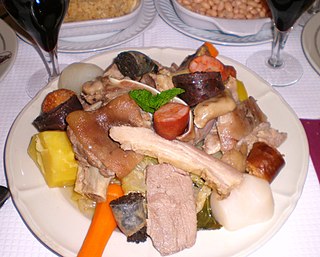Chouriço doce is a blood sausage prepared with pig blood, brown sugar [1] or honey, [2] [3] cashew nuts and spices. [1] Some versions are prepared using almonds. [2] It has been stated that the dish requires six hours to prepare. [1]

Blood sausages, often called blood pudding in British English are sausages filled with blood that are cooked or dried and mixed with a filler until they are thick enough to solidify when cooled. Variants are found worldwide. Pig, cow, sheep, duck, and goat blood can be used, varying by country.

Brown sugar is a sucrose sugar product with a distinctive brown color due to the presence of molasses. It is either an unrefined or partially refined soft sugar consisting of sugar crystals with some residual molasses content, or it is produced by the addition of molasses to refined white sugar.
This is a traditional Portuguese [2] [4] dish from the area of Trás-os-Montes. The dish is served in the Sertão do Seridó communities of Rio Grande do Norte, Brazil as a main dish for a Christmas dinner. [1]

Despite being relatively restricted to an Atlantic sustenance, Portuguese cuisine has many Mediterranean influences. Portuguese cuisine is famous for seafood. The influence of Portugal's former colonial possessions is also notable, especially in the wide variety of spices used. These spices include piri piri and black pepper, as well as cinnamon, vanilla and saffron. Olive oil is one of the bases of Portuguese cuisine, which is used both for cooking and flavouring meals. Garlic is widely used, as are herbs, such as bay leaf and parsley.

Rio Grande do Norte is one of the states of Brazil, located in the northeastern region of the country, occupying the northeasternmost tip of the South American continent. Because of its geographic position, Rio Grande do Norte has a strategic importance. The capital and largest city is Natal. It is the land of the folklorist Luís da Câmara Cascudo and, according to NASA, it has the purest air in the Americas. Its 410 km (254 mi) of sand, much sun, coconut palms and lagoons are responsible for the fame of beaches. Rocas Atoll, the only such feature in the Atlantic Ocean, is part of the state. The main economic activity is tourism, followed by the extraction of petroleum, agriculture, fruit growing and extraction of minerals, including considerable production of seasalt, among other economic activities. The state is famous for having many popular attractions such as the Cashew of Pirangi, the dunes and the dromedaries of Genipabu, the famous beaches of Ponta Negra, Maracajaú and Pipa's paradise, the Carnatal the largest off-season carnival in Brazil, the Forte dos Reis Magos is a sixteenth-century fortress, the hills and mountains of Martins, the Natal Dunes State Park the second largest urban park in the country, and several other attractions. The state is also closest to the archipelago of Fernando de Noronha.












